2019 MERCEDES-BENZ GLE COUPE engine
[x] Cancel search: enginePage 6 of 697

Area pe
rmeable toradio wav es on the
windscreen ................................................ .163
Infrared-reflective windscreen function ...... 16 4Climate control
........................................ 16 5
Overview of climate contro l systems ..........1 65
Operating the climate control sy stem ......... 167 Driving and pa
rking ................................. 17 9
Driving ........................................................ 17 9
DY NA MIC SELECT switch ............................1 94
Au tomatic transmission .............................. 197
Fu nction of the 4MATIC .............................. 201
Re fuelling ................................................... 202
Pa rking ...................................................... .208
Driving and driving saf ety sy stems .............. 217
Tr ailer hit ch................................................ 296
Bicycle rack function .................................. 301
Ve hicle towing instructions ........................ .303 Instrument Display and on-board
comp uter.................................................. 304
Instrument display overview ...................... .304 Overview of
the buttons on thesteering
wheel ..........................................................3 05
Operating the on-board computer .............. 305
Ad justing the design of the instrument
display ........................................................ 307
Showing display conte nt onthe instru‐
ment clus ter ............................................... 307
Overview of displa yson the multifunc‐
tion display .................................................3 09
Ad justing the instrument lighting ................3 10
Menus and submenus ................................. 310
Head-up Display .......................................... 317 LINGU
ATRO NIC ......................................... 319
No tes on operating saf ety .......................... .319
Operation ................................................... 320
Using LINGU ATRO NIC ef fectively ............... 322
Essential voice commands ........................ .323 MBUX multimedia sy
stem ...................... 339
Overview and operation .............................. 339
Sy stem settings .......................................... 374
Na vigation .................................................. 384
Te lephone .................................................. .426 Online and Internet functions ..................... 466
Media .......................................................... 475
Ra dio .......................................................... 483
Sound .........................................................4 86
Re ar Seat En tertainment Sy stem ................4 88 Maintenance and care
.............................495
ASS YST PLUS service inter val display ........ 495
Engine compartment .................................. 496
Cleaning and care ...................................... .502 Breakdown assi
stance ............................. 513
Emergency ................................................. .513
Flat tyre ....................................................... 51 5
Battery (vehicle) .......................................... 521
To w- starting or towing away ....................... 527
Electrical fuses ........................................... 531 Wheels and tyres
..................................... 534
No tes on noise or unusual handling char‐
acteristics .................................................. .534
No tes on regularly inspecting wheels and
tyres ........................................................... 534 Contents
3
Page 7 of 697

No
tes on snow chains ................................ 534
Ty re pressure .............................................. 535
Wheel change ............................................ .542
Emergency spa rewheel .............................. 552
Collapsible spare wheel .............................. 554 Te
ch nical data .......................................... 558
No tes on tech nical da ta.............................. 558
On-board electronics .................................. 558
Ve hicle identification plate, VIN and
engine number overview ............................ 560
Operating fluids .......................................... 562
Ve hicle data ................................................ 571
Tr ailer hit ch................................................. 574Display messages and
warning/indi‐
cator lamps ............................................... 577
Displ aymessa ges ....................................... 577
Wa rning and indicator lamps ...................... 633 Index
......................................................... 6484
Contents
Page 14 of 697
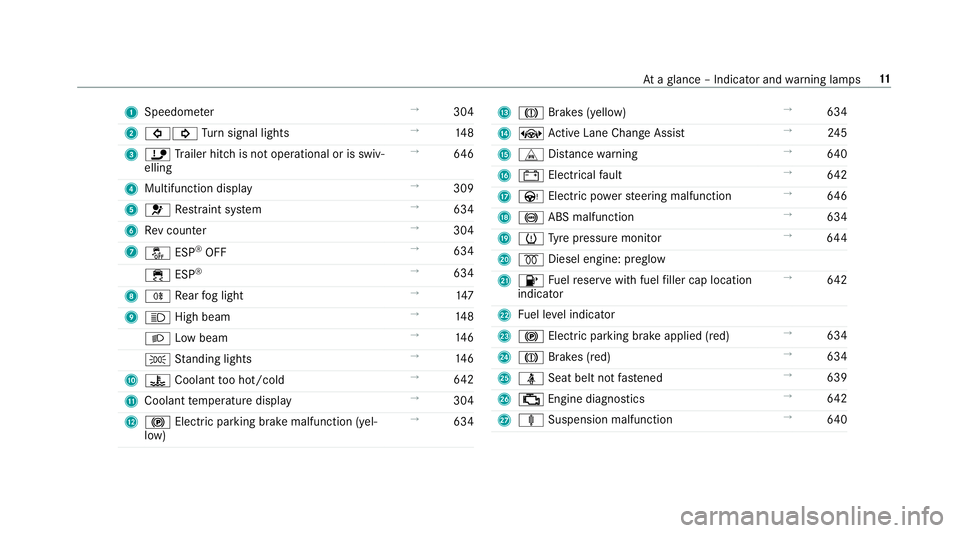
1
Speedom eter →
304
2 #! Turn signal lights →
14 8
3 ï Trailer hit chis not operational or is swiv‐
elling →
646
4 Multifunction display →
309
5 6 Restra int sy stem →
634
6 Rev counter →
304
7 å ESP®
OFF →
634
÷ ESP®
→
634
8 R Rear fog light →
147
9 K High beam →
14 8
L Low beam →
14 6
T Standing lights →
14 6
A ? Coolant too hot/cold →
642
B Coolant temp erature display →
304
C ! Electric pa rking brake malfunction (yel‐
low) →
634 D
J Brakes (yellow) →
634
E ± Active Lane Change Assi st→
24 5
F L Distance warning →
640
G # Electrical fault →
642
H Ù Electric po werst eering malfunction →
646
I ! ABS malfunction →
634
J h Tyre pressure monitor →
644
K % Diesel engine: preglow
L 8 Fuelreser vewith fuel filler cap location
indicator →
642
M Fuel le vel indicator
N ! Electric parking brake applied (red) →
634
O J Brakes (red) →
634
P ü Seat belt not fastened →
639
Q ; Engine diagnostics →
642
R ä Suspension malfunction →
640 At
aglance – Indicator and warning lamps 11
Page 25 of 697
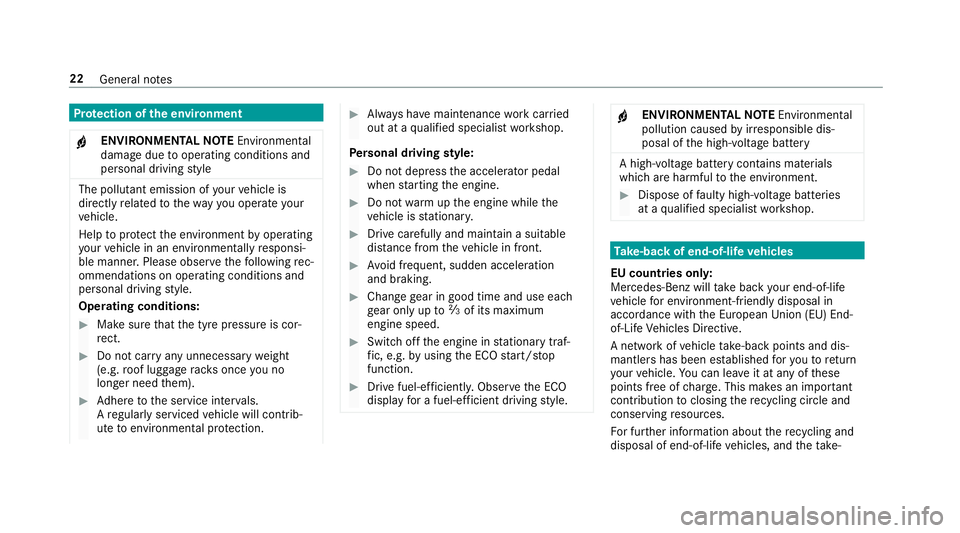
Pr
otection of the environment
+ ENVIRONMENTAL
NOTEEnvironmental
dama gedue tooperating conditions and
personal driving style The pollutant emission of
your vehicle is
directly related tothewa yyo u operate your
ve hicle.
Help toprotect the environment byoperating
yo ur vehicle in an environmentally responsi‐
ble manner. Please obser vethefo llowing rec‐
ommendations on ope rating conditions and
pe rsonal driving style.
Operating conditions: #
Make sure that the tyre pressure is cor‐
re ct. #
Do not car ryany unnecessary weight
(e.g. roof luggage rack s once you no
lon ger need them). #
Adhere tothe service inter vals.
A regularly serviced vehicle will contri b‐
ute toenvironmen tal pr otection. #
Alw ays ha vemaintenance workcar ried
out at a qualified specialist workshop.
Pe rsonal driving style: #
Do not depress the accelera tor pedal
when starting the engine. #
Do not warm upthe engine while the
ve hicle is stationar y. #
Drive carefully and maintain a suitable
di st ance from theve hicle in front. #
Avoid frequent, sudden acceleration
and braking. #
Change gear in good time and use each
ge ar on lyup toÔ of its maximum
engine speed. #
Switch off the engine in stationary traf‐
fi c, e.g. byusing the ECO start/ stop
function. #
Drive fuel-ef ficiently. Obser vethe ECO
display for a fuel-ef ficient driving style. +
ENVIRONMEN
TALNO TEEnvironmental
pollution caused byirre sponsible dis‐
posal of the high-voltage battery A high-voltage battery conta
ins materials
which are harmful tothe environment. #
Dispose of faulty high-voltage bat teries
at a qualified specialist workshop. Ta
ke -back of end-of-life vehicles
EU countries onl y:
Mercedes-Benz will take back your end-of-life
ve hicle for environment-friendly disposal in
accordance with the European Union(EU) End-
of-Life Vehicles Directive.
A network of vehicle take -ba ckpoints and dis‐
mantlers has been es tablished foryo uto return
yo ur vehicle. You can lea veit at any of these
points free of charge . This makes an impor tant
contribution toclosing there cycling circle and
conse rving resources.
Fo r fur ther information about there cycling and
disposal of end-of-li fevehicles, and theta ke- 22
General no tes
Page 91 of 697
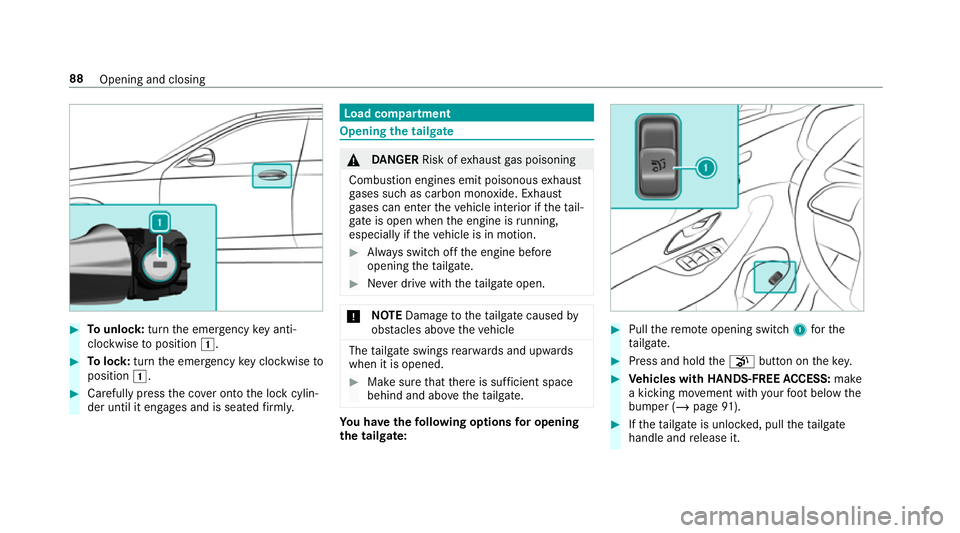
#
Tounlo ck:turn the emer gency key anti-
clo ckwise toposition 1. #
Tolock: turnthe emer gency key clo ckwise to
position 1. #
Carefully press the co ver onto the lock cylin‐
der until it engages and is seated firm ly. Load compa
rtment Opening the tail
gate &
DANG ER Risk of exhaust gas poisoning
Combustion engines emit poisonous exhaust
ga ses such as carbon monoxide. Exhaust
ga ses can enter theve hicle interior if theta il‐
gate is open when the engine is running,
especially if theve hicle is in motion. #
Alw ays switch off the engine before
opening theta ilgate. #
Never drive with theta ilgate open. *
NO
TEDama getotheta ilgate caused by
obs tacles ab ovetheve hicle The
tailgate swings rear wa rds and upwards
when it is opened. #
Make sure that there is suf ficient space
behind and ab ovetheta ilgate. Yo
u ha vethefo llowing options for opening
the tail gate: #
Pull there mo teopening switch 1forthe
ta ilgate. #
Press and hold thep button on thekey. #
Vehicles with HANDS-FREE ACCESS: make
a kicking mo vement with your foot below the
bumper (/ page91). #
Ifth eta ilgate is unloc ked, pull theta ilgate
handle and release it. 88
Opening and closing
Page 111 of 697
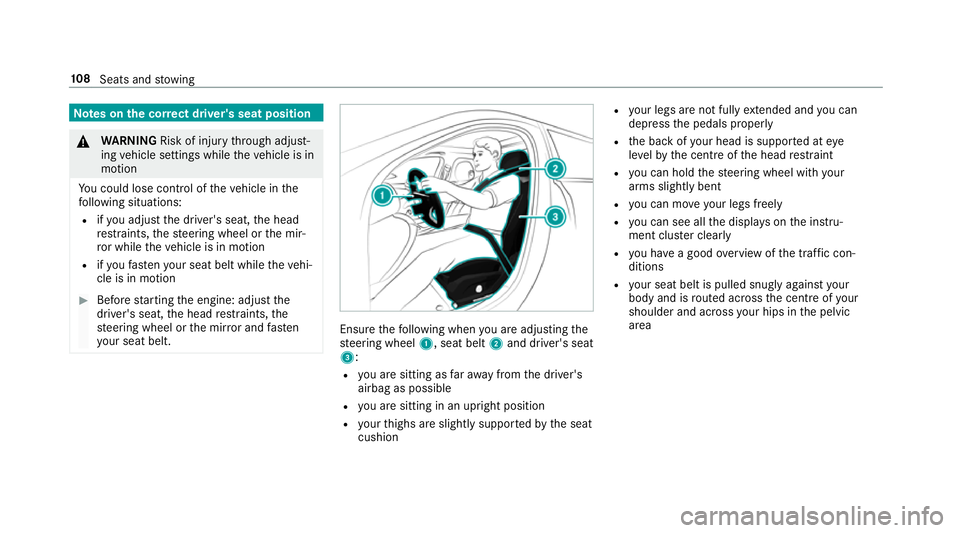
Note
s onthe cor rect driver's seat position &
WARNING Risk of inju rythro ugh adjust‐
ing vehicle settings while theve hicle is in
motion
Yo u could lose cont rol of theve hicle in the
fo llowing situations:
R ifyo u adjust the driver's seat, the head
re stra ints, thesteering wheel or the mir‐
ro r while theve hicle is in motion
R ifyo ufast enyour seat belt while theve hi‐
cle is in motion #
Before starting the engine: adjust the
driver's seat, the head restra ints, the
st eering wheel or the mir ror and fasten
yo ur seat belt. Ensure
thefo llowing when you are adjusting the
st eering wheel 1, seat belt 2and driver's seat
3:
R you are sitting as faraw ay from the driver's
airbag as possible
R you are sitting in an upright position
R your thighs are slight lysuppor tedby the seat
cushion R
your legs are not fully extended and you can
depress the pedals properly
R the back of your head is suppo rted at eye
le ve lby the cent reofthe head restra int
R you can hold thesteering wheel with your
arms slightly bent
R you can mo veyour legs freely
R you can see all the displa yson the instru‐
ment clus ter clea rly
R you ha vea good overview of the traf fic con‐
ditions
R your seat belt is pulled snug lyagainst your
body and is routed across the cent reofyour
shoulder and across your hips in the pelvic
area 108
Seats and stowing
Page 112 of 697
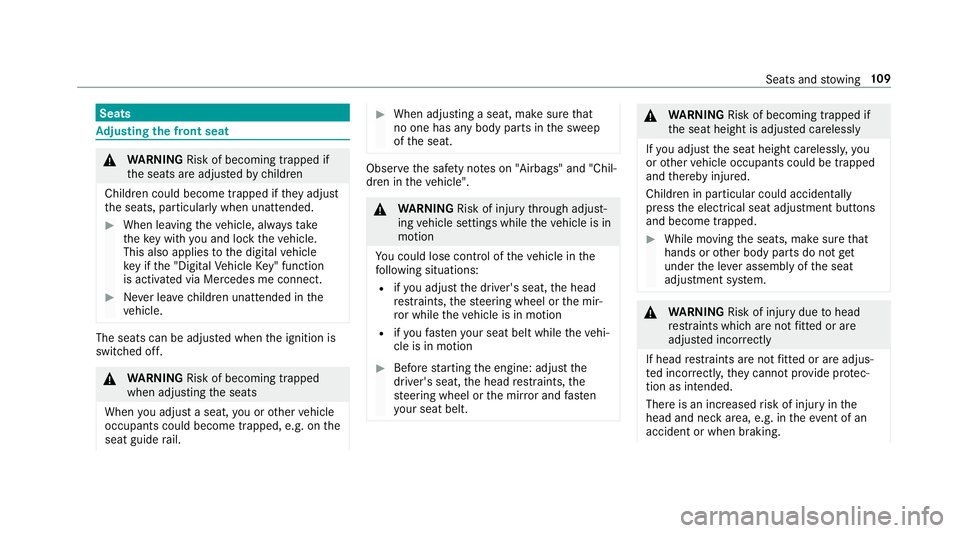
Seats
Ad
justing the front seat &
WARNING Risk of becoming trapped if
th e seats are adjus tedby children
Children could become trapped if they adjust
th e seats, particularly when unattended. #
When leaving theve hicle, alw aysta ke
th eke y with you and lock theve hicle.
This also applies tothe digital vehicle
ke y if the "Digital Vehicle Key" function
is activated via Mercedes me connect. #
Never lea vechildren unat tended in the
ve hicle. The seats can be adjus
ted when the ignition is
switched off. &
WARNING Risk of becoming trapped
when adjusting the seats
When you adjust a seat, you or other vehicle
occupants could become trapped, e.g. on the
seat guide rail. #
When adjusting a seat, make sure that
no one has any body parts in the sweep
of the seat. Obser
vethe saf ety no tes on "Airbags" and "Chil‐
dren in theve hicle". &
WARNING Risk of inju rythro ugh adjust‐
ing vehicle settings while theve hicle is in
motion
Yo u could lose cont rol of theve hicle in the
fo llowing situations:
R ifyo u adjust the driver's seat, the head
re stra ints, thesteering wheel or the mir‐
ro r while theve hicle is in motion
R ifyo ufast enyour seat belt while theve hi‐
cle is in motion #
Before starting the engine: adjust the
driver's seat, the head restra ints, the
st eering wheel or the mir ror and fasten
yo ur seat belt. &
WARNING Risk of becoming trapped if
th e seat height is adjus ted carelessly
If yo u adjust the seat height carelessly, you
or other vehicle occupants could be trapped
and thereby injured.
Children in particular could acciden tally
press the electrical seat adjustment buttons
and become trapped. #
While moving the seats, make sure that
hands or other body parts do not get
under the le ver assembly of the seat
adjustment sy stem. &
WARNING Risk of inju rydue tohead
re stra ints which are not fitted or are
adjus ted inco rrectly
If head restra ints are not fitted or are adjus‐
te d incor rectl y,they cannot pr ovide pr otec‐
tion as intended.
There is an increased risk of injury in the
head and neck area, e.g. in theeve nt of an
accident or when braking. Seats and
stowing 109
Page 115 of 697
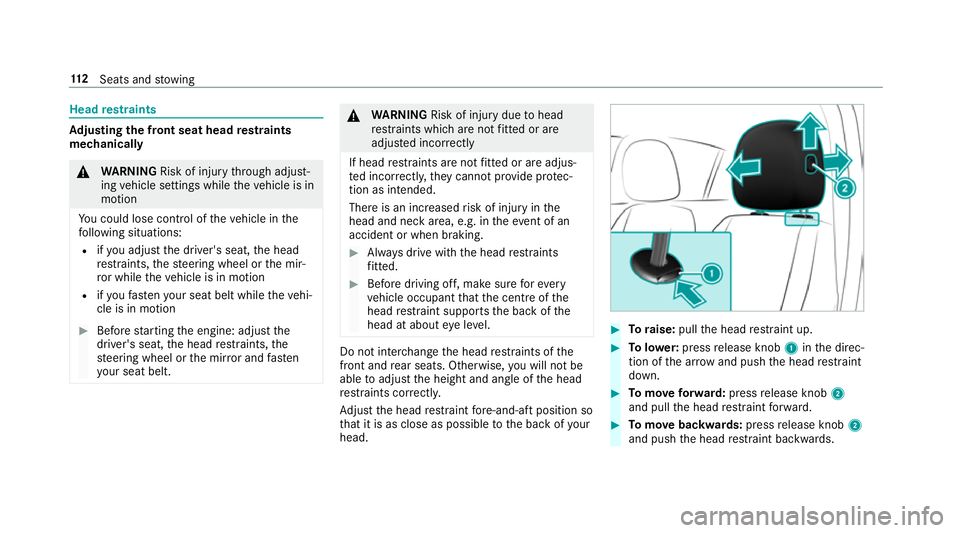
Head
restra ints Ad
justing the front seat head restra ints
mechanically &
WARNING Risk of inju rythro ugh adjust‐
ing vehicle settings while theve hicle is in
motion
Yo u could lose cont rol of theve hicle in the
fo llowing situations:
R ifyo u adjust the driver's seat, the head
re stra ints, thesteering wheel or the mir‐
ro r while theve hicle is in motion
R ifyo ufast enyour seat belt while theve hi‐
cle is in motion #
Before starting the engine: adjust the
driver's seat, the head restra ints, the
st eering wheel or the mir ror and fasten
yo ur seat belt. &
WARNING Risk of inju rydue tohead
re stra ints which are not fitted or are
adjus ted incor rectly
If head restra ints are not fitted or are adjus‐
te d incor rectl y,they cannot pr ovide pr otec‐
tion as intended.
There is an increased risk of injury in the
head and neck area, e.g. in theeve nt of an
accident or when braking. #
Alw ays drive with the head restra ints
fi tted. #
Before driving off, ma kesure forev ery
ve hicle occupant that the cent reofthe
head restra int supports the back of the
head at about eye le vel. Do not inter
change the head restra ints of the
front and rear seats. Otherwise, you will not be
able toadjust the height and angle of the head
re stra ints cor rectl y.
Ad just the head restra int fore -and-aft position so
th at it is as close as possible tothe back of your
head. #
Toraise: pullthe head restra int up. #
Tolowe r:press release knob 1inthe direc‐
tion of the ar row and push the head restra int
down. #
Tomo veforw ard: press release knob 2
and pull the head restra int forw ard. #
Tomo vebackwards: pressrelease knob 2
and push the head restra int backwards. 11 2
Seats and stowing